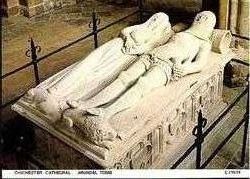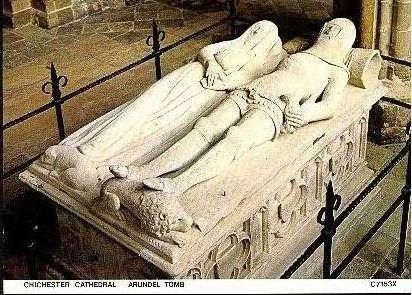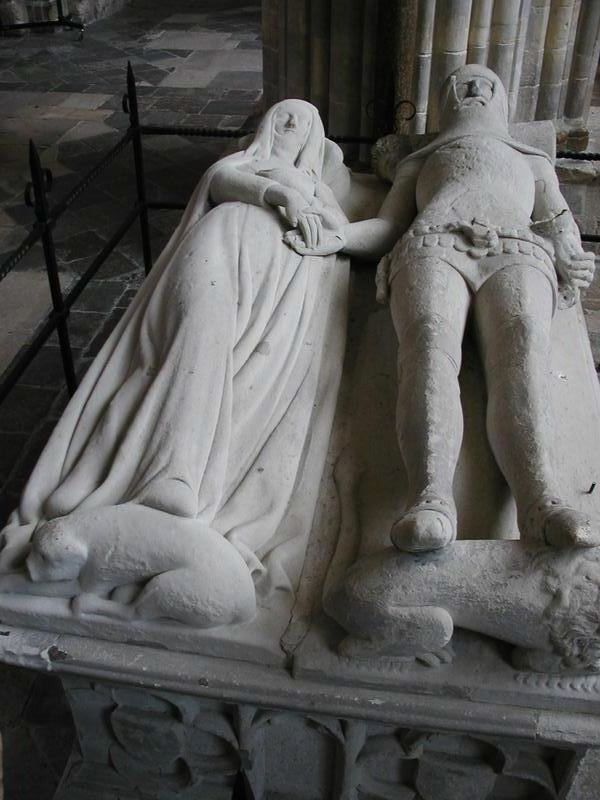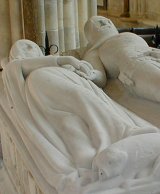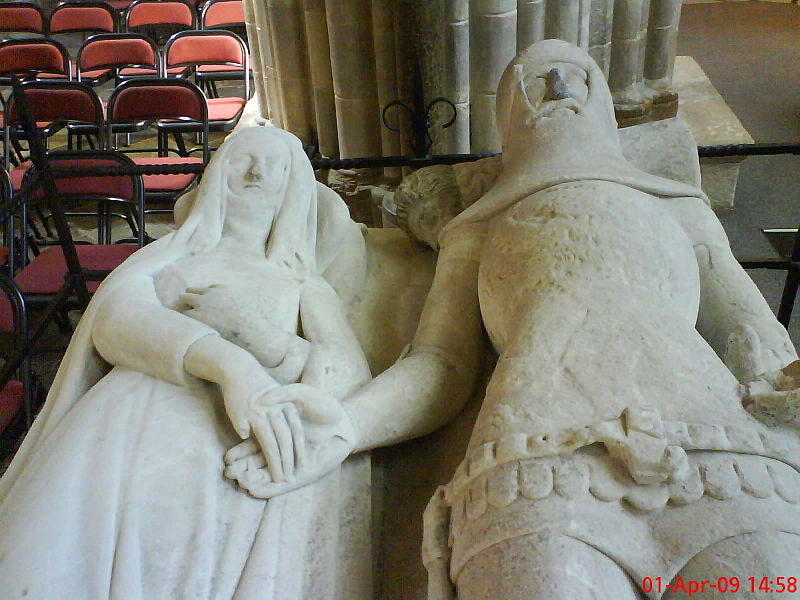Findagrave staff - PLEASE do not merge this memorial with 109796154. Records indicate he was buried in both places, and we will never know which one is truly correct.
Richard has a cenotaph at Lewes Priory, memorial #109796154. Findagrave staff merged it anyway.
Son and heir to Sir Edmund de Arundel FitzAlan and Alice de Warrene. Grandson of Sir William de Warrene and Joan de Vere, Sir Richard Fitzalan and Alice, daughter of Tommaso I, Marquis of Saluzzo.
Husband of Isabel le Despenser, the daughter of Hugh le Despenser "the younger" executed in 1326, and Eleanor de Clare, the daughter of the Earl of Gloucester and Hertford. They were married in the King's Chapel at Havering-atte-Bower, Essex on 09 Feb 1321. They had one son, Sir Edmund, who married Sibyl Montacute. After they were married, her father settled on them, and their heirs, the manors of Keevil, Wiltshire and Wing and Blakewell, Buckinghamshire. The marriage was advantageous in that he allied himself with Edward II's favorites, but Richard had the marriage annulled and his son bastardized on the grounds that he was underage at the time of the marriage and never agreed to the marriage. The marriage was happily annulled by Pope Clement VI in December of 1344, especially since Richard had been living with Eleanor, his second wife. Historians theorize that after Isabel's father was so cruelly executed in 1326, she was suddenly destitute and had no family estate, Richard simply wished to be rid of her.
Secondly, he became the husband of Eleanor Plantagenet of Lancaster, the daughter of Henry Plantagenet, the Earl of Lancaster and Maud Chaworth, and the widow of Sir John de Beaumont who died 14 April 1342. They were married in the presence of King Edward III at Ditton in Stoke Pogis, Buckinghamshire on 05 Feb 1345 by Papal dispensation as they were related in the 3rd and 4th degrees of kindred. Richard and Eleanor had three sons and two daughters:
* Sir Richard, 11th Earl of Arundel 1346-1397
* Sir John, Lord Arundel 1348-1379 drowned
* Thomas, Archbishop of Canterbury 1353-1414
* Joan Arundel, wife of Sir Humphrey de Bohun 1347-1419
* Alice Arundel, wife of Sir Thomas de Holand 1350-1416
Richard also had an illegitimate daughter, Eleanor, who married John de Bereford of Clapcot, Berkshire, Bickford, Stonythorpe and Wishaw, Warwickshire, the illegitimate son of Sir Knight Edmund de Bereford.
Richard's father, Edmund, was executed by Queen Isabel and her minion, Richard de Mortimer, resulting in the forfeiture of his lands and honors. In 1331, Richard was fully restored to his legacy, obtained the Castle and honors of Arundel, thusly becoming Lord Arundel. Heir to his uncle, Sir John de Warenne, he inherited vast estates including those in Surrey, and Norfolk. He also regained family estates in Sussex and the Welsh Marches as one of Edward, the Black Prince's most trusted advisers. In 1359, he loaned the Prince £2000, receiving as security the gold crown and star of the French King. Richard also loaned Edward III large sums of money. When his uncle's wife, Joan of Bar died in 1361, Richard became the Earl of Surrey.
Sir Richard distinguished himself in the French and Scottish wars, fought at the Battle of Sluys, then Tournai, became Warden o the Scottish Marches, and appointed Lieutenant of Aquitaine in 1340. Sir Richard was one of the principal English commanders in the second division at the Battle of Crecy in 1346.
Richard FitzAlan of Arundel became one of the most powerful of the lords of the northern March, who had 1900 pounds in his coffers at Holt and Clun. In an era where a magnificent tomb of marble cost £8, this was an enormous sum.
Despite his high offices in Wales, in the following decades Arundel spent much of his time fighting in Scotland (during the Second Wars of Scottish Independence) and France (during the Hundred Years' War). In 1337, Arundel was made joint commander of the English army in the north, and the next year he was made the sole commander. He fought in the fall of Calais in 1347.
Richard died at Arundel Castle and was buried at Lewes Priory in Lewes, Sussex, England. In his will Richard requested to be buried "near to the tomb of Eleanor de Lancaster, my wife; and I desire that my tomb be no higher than hers, that no men at arms, horses, hearse, or other pomp, be used at my funeral, but only five torches...as was about the corpse of my wife, be allowed."
Despite all records indicating Richard and Eleanor were buried at Lewes Priory, there is a tomb for them at Chicester Cathedral as well. Richard's death is recorded as 24 January 1376 in Sussex, England. One more source says he wrote his will on 5 December 1375, and died on 14 January 1376 at Arundel Castle.
This burial per the memorial's originator.
Findagrave staff - PLEASE do not merge this memorial with 109796154. Records indicate he was buried in both places, and we will never know which one is truly correct.
Richard has a cenotaph at Lewes Priory, memorial #109796154. Findagrave staff merged it anyway.
Son and heir to Sir Edmund de Arundel FitzAlan and Alice de Warrene. Grandson of Sir William de Warrene and Joan de Vere, Sir Richard Fitzalan and Alice, daughter of Tommaso I, Marquis of Saluzzo.
Husband of Isabel le Despenser, the daughter of Hugh le Despenser "the younger" executed in 1326, and Eleanor de Clare, the daughter of the Earl of Gloucester and Hertford. They were married in the King's Chapel at Havering-atte-Bower, Essex on 09 Feb 1321. They had one son, Sir Edmund, who married Sibyl Montacute. After they were married, her father settled on them, and their heirs, the manors of Keevil, Wiltshire and Wing and Blakewell, Buckinghamshire. The marriage was advantageous in that he allied himself with Edward II's favorites, but Richard had the marriage annulled and his son bastardized on the grounds that he was underage at the time of the marriage and never agreed to the marriage. The marriage was happily annulled by Pope Clement VI in December of 1344, especially since Richard had been living with Eleanor, his second wife. Historians theorize that after Isabel's father was so cruelly executed in 1326, she was suddenly destitute and had no family estate, Richard simply wished to be rid of her.
Secondly, he became the husband of Eleanor Plantagenet of Lancaster, the daughter of Henry Plantagenet, the Earl of Lancaster and Maud Chaworth, and the widow of Sir John de Beaumont who died 14 April 1342. They were married in the presence of King Edward III at Ditton in Stoke Pogis, Buckinghamshire on 05 Feb 1345 by Papal dispensation as they were related in the 3rd and 4th degrees of kindred. Richard and Eleanor had three sons and two daughters:
* Sir Richard, 11th Earl of Arundel 1346-1397
* Sir John, Lord Arundel 1348-1379 drowned
* Thomas, Archbishop of Canterbury 1353-1414
* Joan Arundel, wife of Sir Humphrey de Bohun 1347-1419
* Alice Arundel, wife of Sir Thomas de Holand 1350-1416
Richard also had an illegitimate daughter, Eleanor, who married John de Bereford of Clapcot, Berkshire, Bickford, Stonythorpe and Wishaw, Warwickshire, the illegitimate son of Sir Knight Edmund de Bereford.
Richard's father, Edmund, was executed by Queen Isabel and her minion, Richard de Mortimer, resulting in the forfeiture of his lands and honors. In 1331, Richard was fully restored to his legacy, obtained the Castle and honors of Arundel, thusly becoming Lord Arundel. Heir to his uncle, Sir John de Warenne, he inherited vast estates including those in Surrey, and Norfolk. He also regained family estates in Sussex and the Welsh Marches as one of Edward, the Black Prince's most trusted advisers. In 1359, he loaned the Prince £2000, receiving as security the gold crown and star of the French King. Richard also loaned Edward III large sums of money. When his uncle's wife, Joan of Bar died in 1361, Richard became the Earl of Surrey.
Sir Richard distinguished himself in the French and Scottish wars, fought at the Battle of Sluys, then Tournai, became Warden o the Scottish Marches, and appointed Lieutenant of Aquitaine in 1340. Sir Richard was one of the principal English commanders in the second division at the Battle of Crecy in 1346.
Richard FitzAlan of Arundel became one of the most powerful of the lords of the northern March, who had 1900 pounds in his coffers at Holt and Clun. In an era where a magnificent tomb of marble cost £8, this was an enormous sum.
Despite his high offices in Wales, in the following decades Arundel spent much of his time fighting in Scotland (during the Second Wars of Scottish Independence) and France (during the Hundred Years' War). In 1337, Arundel was made joint commander of the English army in the north, and the next year he was made the sole commander. He fought in the fall of Calais in 1347.
Richard died at Arundel Castle and was buried at Lewes Priory in Lewes, Sussex, England. In his will Richard requested to be buried "near to the tomb of Eleanor de Lancaster, my wife; and I desire that my tomb be no higher than hers, that no men at arms, horses, hearse, or other pomp, be used at my funeral, but only five torches...as was about the corpse of my wife, be allowed."
Despite all records indicating Richard and Eleanor were buried at Lewes Priory, there is a tomb for them at Chicester Cathedral as well. Richard's death is recorded as 24 January 1376 in Sussex, England. One more source says he wrote his will on 5 December 1375, and died on 14 January 1376 at Arundel Castle.
This burial per the memorial's originator.
